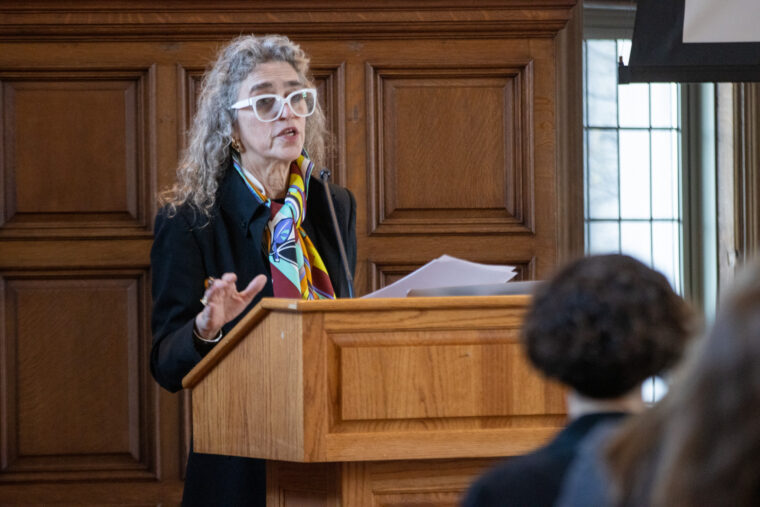News
Laura Levitt gives lecture on ‘Objects that Remain’

Laura Levitt, author and professor of Religion, Jewish studies, and Gender at Temple University, spoke about her book The Objects That Remain in a lecture hosted by the Danforth Center on Religion and Politics on March 6.
Levitt has written several books on Jewish studies and feminism, and has taught at Temple since 1992. There, she has chaired the Religion Department, and currently chairs the Committee on Sexual Misconduct for the Association for Jewish Studies.
Around 40 people attended the lecture in Washington University’s Umrath Lounge where Levitt explained why she wrote her most recent book, The Objects That Remain. She described the connections she found between the preservatory work done for objects involved in the Holocaust and objects in custody of the criminal justice system.
Levitt also provided a basic understanding of what these objects offer people today and how they should be treated.
“Objects that remain in places like the Holocaust Museum or in police storage and the stories that surround them enable us to do justice,” she said. “Once ordinary objects now enable a form of intimacy and companionship, a different kind of reckoning through holding and telling stories and sharing them with others.”
Levitt emphasized the importance of caring for objects involved in traumatic and violent experiences by saying they “help us reconstruct lives after trauma and loss.”
She began considering the importance of these items after reading the works of Maggie Nelson, a writer, and Edmund De Waal, a potter and author. Levitt said that Nelson and De Waal’s work had a significant impact on her.
“They were writing in a way that made sense to me,” she said. “I use my reading of [their] works to tell my own story.”
According to Levitt, Nelson’s book Jane: A Murder, a collection of poems written to Nelson’s aunt who was murdered before she was born, catalyzed this realization; in Nelson’s aunt’s case, multiple objects from the night of the murder were brought to court as evidence.
“I found that shocking and strange, and I had not thought about my own clothes and bedding that were taken by the police as evidence,” she said, regarding her experience with police after she was raped by an intruder into her home.
Although the objects involved in Levitt’s rape were lost, she understood that their existence brought out the importance of caring for objects that remain, whether they are related to trauma or not.
“Only by attending to my own, abiding love for things and the terrible legacy of my own lost evidence could I begin to appreciate what it meant to have choices to be able to decide what to do with our possessions.”
As she was reading Nelson and De Waal’s work, Levitt found contrasts between the amount of care given to objects by the criminal justice system and those working to preserve Holocaust-related objects. To Levitt, Holocaust preservation work was a “sacred labor.”
“Objects cannot survive without human attention,” she continued. She accompanied these words with pictures of how objects involved in the Holocaust are handled, emphasizing the use of climate-controlled rooms and gloves. In contrast, she criticized how the juridical system views objects involved in crimes.
“The law cares about the chain of custody or provenance of criminal evidence, but treat such objects as if, once in custody, the work of holding them is done,” she said.
In writing her book, Levitt took a class alongside police officers to get a better understanding of the treatment of objects involved in violent crimes. She said her experience there cemented her critical view of police practices in comparison to work on Holocaust objects.
“Although seemingly similar practices are at work in the criminal justice system, these are quite different operations,” she said. “This is a decentralized set of operations in the United States… there are no standards.”
Maxwell Greenberg, a postdoctoral fellow at Washington University in Jewish Studies, shared Levitt’s concern.
“The care that goes into [preservation] work is wonderful, though care over Holocaust-related objects really is the exception,” Greenberg said to Student Life after the event. “The US should fund similar work that is done in museums like the Holocaust Museum for its own genocides,” he added.
WashU librarian AJ Robinson recognized Levitt’s work as offering critical lessons for their own.
“As curators, we lose track of the impacts of decisions made about curating,” they said. “Emotion gets lost. Levitt did a wonderful job explaining the importance of telling the stories of the objects we display.”
Towards the end of her lecture, Levitt mentioned the importance of seeking out and discussing these types of items.
“Such vital artifacts animate these legacies and in so doing, they enable us to share their stories,” she said. “This kind of sharing is, I believe, an alternative form of doing justice, a partial answer to the loneliness of life after such violation.”
Levitt ended by pointing out to the audience their potential role in preservation work. “If an artist, a poet, a scholar, a student, goes to the museum and the museum collection is open, you can have access to those things and be a part of the telling of those stories.”
